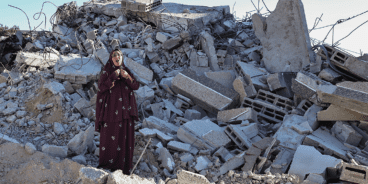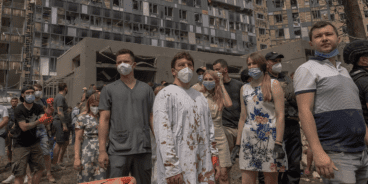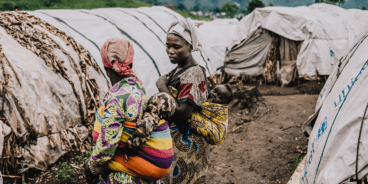
Did Qaddafi’s End Justify the Means?
The following is a roundtable discussion organized by Foreign Policy on what humanitarian intervention in the post-Libya world will look like. Panelists include David Bosco, Micah Zenko, Gareth Evans and Kyle Matthews.
When international forces struck against Muammar al-Qaddafi’s military outside the rebel stronghold of Benghazi in March — the beginning of the end for the Libyan dictator who was killed on Oct. 20 in his hometown of Sirte — they were acting on a doctrine called “responsibility to protect,” or R2P. The idea, not even a decade old and only embraced by the United Nations in 2005, is that a country’s government could be held accountable — with military force, if necessary — for failing to ensure the well-being of its citizens. In our November issue, Foreign Policy explores the history of this doctrine — but what about its future? Was the successful toppling of the Qaddafi regime a new dawn for muscular humanitarianism or a false one? Did the invasion make the world less safe for dictators or for the rest of us? We convened a roundtable of experts to weigh in on what humanitarian intervention in the post-Libya world will look like.
David Bosco: How Libya made humanitarian intervention less likely
Imagine this alternate reality: In April 1994, thousands of American, British, and French forces seize control of the airport in Kigali, Rwanda, and then fan out across the country to stop what officials describe as an incipient genocide. As they attempt to restore order, the Western troops confront and clash with Hutu extremists. Several American soldiers are killed by snipers and a helicopter crash kills a dozen more. In Washington, Bill Clinton’s administration faces outrage over the intervention, which draws immediate comparisons to the failed Somalia mission. Claims by administration officials that they prevented a massive bloodletting are greeted with derision on Capitol Hill, where support for costly humanitarian missions is weak.
All of which is to say that the “responsibility to protect” (R2P), the doctrine that guided this year’s international intervention in Libya, has a structural problem, at least insofar as it involves military action to prevent atrocities. Early intervention in Rwanda might have saved as many as 500,000 lives, a stunning achievement. But it’s almost certain that such a mission would not have been viewed as a stunning success. The problem is that R2P’s successes will always be ambiguous and debatable, dogged by “what if”s. Its costs, meanwhile, will be painfully evident in the form of military expenditures and casualties and in whatever unintended consequences may follow an intervention. For that reason, the doctrine will struggle to build a record of success and cement its place as an international norm.
This dynamic has been apparent in Libya. British, French, and American leaders insist that they averted a massacre in Benghazi, but such claims are impossible to prove and easy to doubt, as many close observers of the situation have. Meanwhile, critics of the operation can without fear of contradiction point to the mission’s price tag, the political complexities of post-Qaddafi Libya, and the diplomatic strains that the mission has produced with other U.N. Security Council members and within the NATO alliance. At least in the medium term, Libya has made humanitarian interventions less likely.
Coercive intervention is not the entirety of the R2P doctrine, which is fundamentally an attempt to change conceptions of what national sovereignty means. But a government that is clinging to power by violence can usually only be stopped by force. R2P is well on its way to becoming boilerplate in official reports, resolutions, and speeches. As an operational doctrine, however, it will always have to fight for its life.
David Bosco is an assistant professor at American University’s School of International Service and writes the Multilateralist blog for FP.
Micah Zenko: After Qaddafi, every dictator will want to get his hands on a nuclear weapon
The world has entered an era characterized by two contradictory dynamics. The first is the “responsibility to protect” (R2P) doctrine, which states that each government is individually responsible for protecting its population from genocide, war crimes, ethnic cleansing, and crimes against humanity. If a government cannot — or will not — meet its R2P obligations, then the international community can use military force to protect that state’s populace and, potentially, to ensure the removal of offending regimes — as has happened in the Ivory Coast and Libya this year.
The second dynamic is the prevention or rolling-back of states’ acquisitions of weapons of mass destruction (WMD) and ballistic missiles. As authoritarian governments face escalating international scrutiny over their treatment of their people, they have an increasingly greater incentive to develop WMD programs to deter foreign military interventions enforcing R2P. In short, advocates of R2P may be inadvertently encouraging proliferation, because no government possessing WMD has ever been invaded and overthrown by an outside military force.
Toppled Libyan leader Muammar al-Qaddafi gave up his country’s nascent nuclear program in 2003 and 2004, removing the potential capability that would have deterred the NATO-led intervention. When Qaddafi handed uranium-enrichment centrifuge components and nuclear weapons blueprints to the United States, he sealed his own fate. Qaddafi’s daughter, Aisha, promised that the lesson to take from Libya is that “every country that has weapons of mass destruction [should] keep them or make more so they will not meet the same fate as Libya.”
Policymakers and analysts increasingly use the term “R2P” to describe malevolent state behaviors that fall outside the four specific crimes and violations mentioned above, and sovereign governments are held accountable for them under the obligations of R2P, with evidence immediately provided by citizens using social media, human rights investigators, and journalists. In Libya, for example, only 77 days passed between the country’s referral by the U.N. Security Council to the International Criminal Court (ICC) and the issuing of indictments and arrest warrants for Qaddafi and two senior officials by ICC prosecutors.
Combined with such scrutinized governmental behavior, the international community likewise increasingly faces R2P obligations to protect vulnerable populations through diplomatic, economic, and coercive military means. In August, U.S. President Barack Obama declared as much for the first time: “Preventing mass atrocities and genocide,” he stated, “is a core national security interest and a core moral responsibility of the United States.”
Libya will assuredly not be the final country that faces coercive threats for treating its population poorly. Depending on how you define them, there are between 20 and 45 authoritarian governments in the world. Several are already pursuing WMD and have either never signed the Nuclear Non-Proliferation Treaty, Chemical Weapons Convention, and Biological Weapons Convention or are suspected to be in violation of treaty obligations.
Qaddafi told then-International Atomic Energy Agency head Mohamed ElBaradei in 2003 that he did not believe that his nuclear program enhanced Libya’s security. He was either lying or wrong. Saddam Hussein, meanwhile, told FBI interrogators that he maintained the perception of having WMDs to not appear weak and to deter another invasion of his country. He was right — not having nuclear weapons made him weak. Authoritarian governments will have learned lessons from both examples of outside regime change, and those will be applied to their own decisions about whether to pursue the bomb.
Micah Zenko is a fellow at the Council on Foreign Relations. He blogs for CFR and is on Twitter at @MicahZenko.
Gareth Evans: Can we stop atrocities without launching an all-out war?
Libya was a textbook case for the application of the “responsibility to protect” (R2P) principle, and the U.N. Security Council resolutions in February and March, which paved the way for the military campaign, were textbook responses. After his regime’s initial attacks on unarmed protesters, Muammar al-Qaddafi was first warned, censured, sanctioned, and threatened with International Criminal Court prosecution; only when it was clear, three weeks later, that neither persuasion nor nonmilitary coercion would change his course and that a civilian massacre in Benghazi was imminent was selective military action authorized. And the intervention worked — at the very least in preventing a catastrophe in Benghazi and many more civilian casualties elsewhere than would otherwise have been the case. Equivalently quick and robust responses would have saved 8,000 lives in Srebrenica and 800,000 in Rwanda.
That’s the good news. But there were also downsides to the action, on which supporters of R2P need to reflect. After the initial strike on Qaddafi’s forces surrounding Benghazi, the NATO-led international forces chose to conduct much more than a watching-brief and selective-strike operation, making the judgment that only by supporting the rebels to achieve regime change could all of Libya’s civilians really be protected. And in doing so they were widely seen –not just by R2P skeptics waiting to pounce — as stretching their narrow Security Council mandate to its absolute limit, if not beyond.
For better or worse, this perception has now given Russia, China, and others an excuse to claim – – in the context of Syria, where regime violence has been if anything worse than in Libya — that there are risks not only in authorizing, but even foreshadowing, any coercive measures at all, because it cannot be assumed that even the most slender Security Council authority will not be misused. We shouldn’t see this as any big setback to the R2P norm itself — support for it is still overwhelming, as demonstrated by a major General Assembly debate on the issue in July. But systematic and effective implementation will continue to be hard work.
Perhaps the most urgent challenge after Libya and Syria is to change the mindset that any kind of robust response is like stepping on a moving staircase with the first condemnatory step implying a willingness and determination to go all the way to full-scale coercive military force. Policymakers and publics have to be persuaded, all over again, that coercive military action is totally different from other response mechanisms and can only be countenanced in extreme and exceptional circumstances.
This cause would be much helped by getting the Security Council or General Assembly to embrace tough guidelines for the use of military force. Five criteria (seriousness of risk, right intention, last resort, proportionality, and balance of consequences) have been advocated from the start by R2P advocates, not as a guaranteed route to consensus but as an important tool for achieving it in hard cases. We lost the battle to endorse such guidelines at the 2005 World Summit. Six years later, this remains important unfinished business.
Gareth Evans is a former foreign minister of Australia, former president of the International Crisis Group, and co-chair of the International Commission on Intervention and State Sovereignty, which initiated the concept of the responsibility to protect. He is the author of The Responsibility to Protect: Ending Mass Atrocity Crimes Once and for All.
Kyle Matthews: Libya is the beginning of the end for the world’s worst villains
Before and after the fall of Muammar al-Qaddafi and his cronies in Libya, many pundits and commentators erroneously blamed the “responsibility to protect” (R2P) doctrine for leading NATO into war. Many have gone further in claiming that R2P is headed for the trash heap, painting the doctrine as neocolonialism hiding behind the mask of humanitarianism. Yet none of them touches upon what actually transpired at the earliest stages of the Libyan crisis, nor do they proffer any practical alternatives for protecting civilians from mass atrocity crimes. This is a shame, because R2P is a rising international norm, not a declining one.
Although the Qaddafi regime was hardly the only Arab government to crack down on peaceful protesters amid the political unrest that swept the region early this year, it was the first to immediately apply military force. So violent was Tripoli’s response that many Libyan diplomats resigned en masse, sickened by the brutality unleashed back home. The fact that Qaddafi threatened to go house to house to take care of the “rats” — all who opposed his dictatorial rule — was most likely the tipping point. All this transpired well before the U.N. Security Council passed Resolution 1973, authorizing the enforcement of a no-fly zone, imposing a weapons ban, and allowing NATO to take all necessary measures to protect civilians.
Successfully applying R2P, especially the military component, has always been hindered by two general groups. The first are countries that have the power to stop atrocities but are fearful of getting bogged down in a quagmire — think of the United States circa 1994. The second are countries that block action, purposely, to protect narrow national interests — think of Russia and China’s recent double veto at the U.N. Security Council to protect the regime of Bashar al-Assad.
Barack Obama’s administration has played a quiet but significant role in reordering this calculus, both by supporting the NATO-led operation in Libya and in its recent decision to deploy 100 troops to Uganda to fight the Lord’s Resistance Army. Even Canada, which once championed R2P but has been silent on the doctrine as of late, is now shifting its foreign policy so that the protection of civilians becomes more prominent. Among the countries — mostly the BRICS — on the other side of the issue, there is a slow realization that shielding tyrants who abuse their people does not play out well on the international stage or, in some cases, with domestic constituencies. Under the leadership of Jacob Zuma, South Africa in particular has been criticized for standing with dictators rather than with humanity, contrary to the legacy of Nelson Mandela.
Governments that do not uphold their responsibility to protect their own citizens from mass atrocity crimes also face an array of organizations and activists who are much better equipped than before to expose the crimes they commit and the countries that back them with military and political support. In an age of instantaneous electronic communication, governments can no longer hermitically seal their borders to suppress information at home or stop it from leaking to the outside world. Thanks to smartphones and social media platforms, the power of witness is only going to strengthen in the years ahead, robbing oppressive regimes of the one card they have left to play.
Kyle Matthews is senior deputy director of the Will to Intervene Project at Concordia University’s Montreal Institute for Genocide and Human Rights Studies.
Related Content


